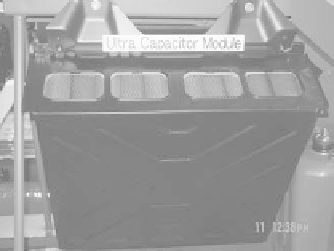Environmental Engineering Reference
In-Depth Information
minus any auxiliary power needs such as powering the air compressor. System
efficiency is the ratio of dc output energy to the lower heating value of hydrogen
rich fuel. High volume production is defined as greater than 500,000 units/year.
Currently, the start-up performance of PEM fuel cell stacks is 2 min to full
power at room temperature and 15 min at
40
C. During the start-up phase,
conventional FCEVs use battery power for vehicle launch and ancillaries. The
Honda FCEV discussed above uses an ultra-capacitor bank for transient energy
storage such as start-up and regeneration. A fuel cell, unlike a conventional battery
is incapable of absorbing regeneration energy. Typically, when a battery or ultra-
capacitor are connected in parallel to the fuel cell stack, a blocking diode is used in
series with the fuel cell to prevent regeneration energy from back flowing into the
stack. Figure 4.40 shows the package location of the ultra-capacitor transient sto-
rage in a fuel cell powered vehicle (note the top portion of a hydrogen fuel canister
at the lower left in Figure 4.40).
Figure 4.40 Ultra-capacitor transient energy storage in Honda FCEV
Near term durability, or operating life of the fuel cell stack, is consistent with
automotive 10 year/150,000 mi. Concerns with durability, other than the stack
itself, are with water management. If the vehicle is parked and the water freezes in
the stack, then one or more of the fuel cells may crack, resulting in an open circuit
and an inoperable stack.
A Pugh analysis of the more promising hydrogen storage technologies is
summarized in Table 4.19. In this table, the column for stand time reflects the
concerns over fuel escape due to venting or inability to access the fuel such as a
metal hydride that must be heated in order to release the trapped gas.
The relative ranking of hydrogen storage technologies by attributes given in
Table 4.19 shows that at the present stage of technology development compressed
gas at 5,000 psi offers the most viable solution.
4.4.6 Ultra-capacitor
Electrolytic double layer capacitors are discussed in depth in Chapter 10. For
this introduction to ultra-capacitors, it will suffice to contrast their energy and









